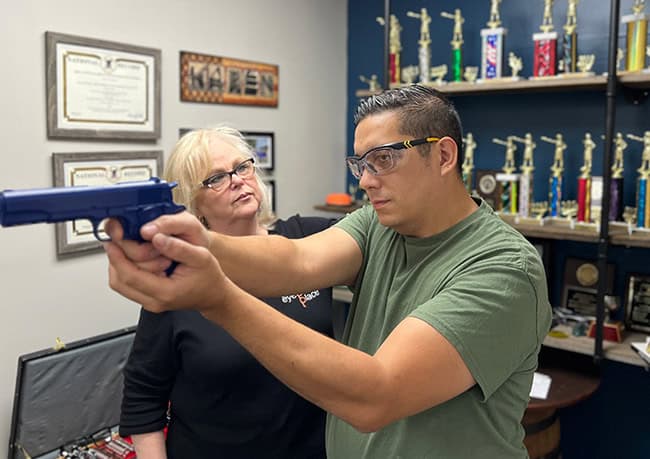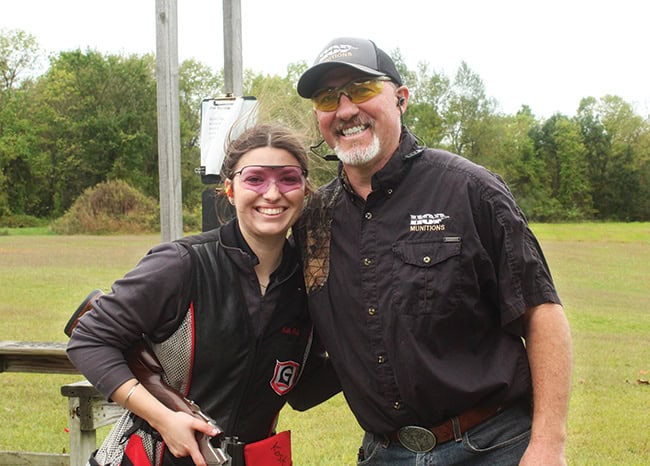The Less-Lethal Alternative
Less-lethal products, like pepper spray, are unlikely to result in serious harm or death to the person they are used against. They aren’t as sexy as guns, but they also have a place on gun store shelves. Why?
Think first of customers who are new to the firearms world. While they are still figuring out what to buy and how to shoot, they still deserve to be safe from the bad guys of the world. Making the decision to purchase is only the first step. It still takes time to save money for the gun, the accessories and the classes. In some states, there’s also time spent waiting for the necessary permits.
Less-lethal products like high-quality pepper sprays are affordable and easy to use. If you’d like to show customers their safety is what matters, more than selling them an expensive gun, offering an affordable and simple means of protection is a good start.
Even after they’ve started down the path of gun ownership, a customer might not be ready to use their new gun to defend themselves. They may not yet be comfortable with their handling skills or their ability to shoot when the pressure is on. They may be hesitant to keep a loaded gun in their home or carried on their body. They may fear the harm that could result if their shot misses its intended target, or if their shot lands exactly where intended.
It can take time to come to peace with the idea that their chosen self-defense tool could seriously injure or even kill someone, even if that person was intending to do the same to them. During that in-between time, or if a customer decides lethal force isn’t for them, you can offer something else better than hope.
Clear The Air
Most states have restrictions on where and when an individual is allowed to carry a gun. A person may also choose not to carry because of the consequences that could occur if they were to violate a workplace policy or family request. Sometimes, they just don’t want to for their own reasons, whatever they might be.
They’ll be looking for alternatives and a one-stop store where a customer can look for all their self-defense needs would be a tempting place to shop.
Make clear, though, the distinctions between lethal and less lethal. There are many misconceptions as to where different tools fit on that spectrum, and what may or may not be legal or permissible in a specific place.
The customer is ultimately responsible for knowing these rules, but you can help by being clear and correct about what you are selling.
Not Every Threat Is Addressed With A Firearm
Less-lethal tools can also complement a carried firearm. As the saying goes, “When all you have is a hammer, everything looks like a nail.” The same can happen with a gun, but not every threat can be addressed by shooting it.
In some cases, drawing or shooting a gun may be unsafe because of the surrounding crowd. In others, lethal force may not be legally or morally warranted. Having something else that can be effective in stopping potentially violent situations can be a helpful option, especially something else that can be used before serious danger is imminent.
Chuck Haggard, a nationally recognized self-defense trainer, recommends pepper spray in particular because it is “between a harsh word and a gun,” giving people who carry it a tangible way of defending themselves without having to shoot a threatening person.
Classroom Opportunity
Stocking less-lethal tools also creates opportunities to enhance existing classes or to offer additional education. Use-of-force considerations become more nuanced when adding the possibility of a less-lethal response, changing the lessons you give in defensive shooting or concealed carry classes.
Whether a student comes in looking to learn when they can use a gun against another person or a customer wonders what they can do if they don’t want to shoot, less-lethal tools are an important discussion point and an important option to have available. In many cases, they can also be practiced without a live-fire range, using training units or dummies.
This allows classes to be taught in more limited facilities, with less equipment, and a higher instructor-to-student ratio. As we know, these opportunities are good for both the store and the students.
Avoid Selling False Hope
Simply stocking your store with a catalog of gadgets advertised as “less lethal” might not be the best idea, though. The customer is ultimately responsible for making sure what they buy is allowed in the places they want to bring it, and that it will be effective in the way they are expecting.
However, you can help set them up for success by doing a little bit of research before ordering inventory. Some items, like various types of knives, are sometimes lumped together with other less-lethal tools, but they are not and should be labeled accordingly. Other items may not be legal in your state or city, even if you can purchase them from your distributor — so you’ll want to check.
And of course, many items aren’t reasonably effective in stopping potential bad guys. Digging into the products you’re choosing among can help avoid selling false hope or confidence.
Offer Solutions
Guns aren’t the appropriate tool for everyone all the time. Why not serve customers who aren’t ready for defensive gun use or who spend time in places where they can’t or don’t want to bring a gun? We can argue about whether any of them should buy or carry a gun anyway, but we can also offer quality alternatives for people in all stages and places of their self-defense journey.
It’s true being responsive to customer demand will increase sales, but you can still balance profit against offering products that will serve your customers the best and keep them the safest they can be in their individual circumstances.






